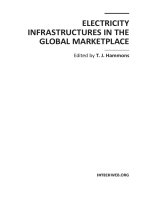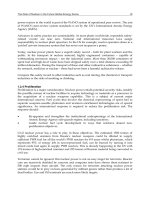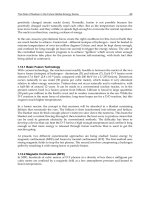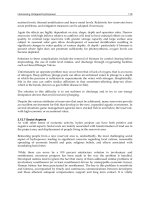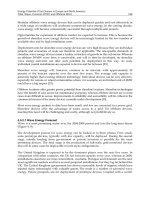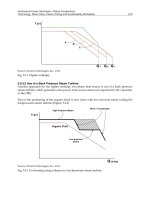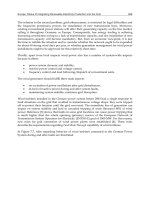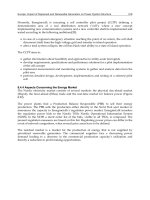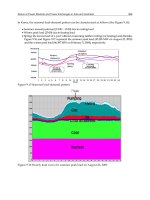Logoplaste.marketing quocte inovation in the global market
Bạn đang xem bản rút gọn của tài liệu. Xem và tải ngay bản đầy đủ của tài liệu tại đây (1.39 MB, 30 trang )
Logoplaste: innovation in the global market
From packaging to solution
The Authors
André Morgado, AESE – School for Management and Business, Centre for Marketing
Studies, Lisbon, Portugal
Acknowledgements
This case was written under the supervision of Professor Teresa Correia de Barros.
Abstract
Purpose – The purpose of this paper is to describe a case that looks at how an innovative plastics
packaging company in Portugal integrates itself into the value chain of company clients. The
pedagogical objectives are: to present a success case in technological, processes and business
innovation; to present a success case in business strategy, based on the build-up of partnerships;
and to construct a platform for discussion of a first mover strategy, and precautions to be taken in
its pursuit.
Design/methodology/approach – A range of evidence, including primary and secondary data, was
used in the writing of this case, namely: direct observation, interviewing, press releases and press
cuttings, annual reports, customer records and organization charts.
Findings – Logoplaste has gained a leadership position and has successfully managed to achieve a
relevant position in the international landscape by seeking a vertical integration of its activities, in
order to obtain a better value proposal for its clients, which, at the same time, allows it to capture a
part of that value for itself. This practice has permitted this company not only to grow overseas but
also to reveal a customer loyalty performance of 100 per cent. These results are deeply connected
with their innovative value proposal, e.g. product innovation, process innovation, marketing
innovation and business model innovation.
Originality/value – This study provides insights into the nature of a company, which has
successfully developed its activity based on a strong investment in innovation since its genesis.
Logoplaste's strategy can be considered distinctive as it combines and integrates the following
strategic vectors: integration of the client's logistical and value chains, based on a process of
partnership developments; investing in R&D of packaging engineering, with the offer of an “vend-
to-end” solution; and production process based on a “wall-to-wall” model.
Article Type:
Case study
Keyword(s):
Innovation; International marketing; Plastics; Packaging; Portugal.
Journal:
Management Decision
Volume:
46
Number:
9
Year:
2008
pp:
1414-1436
Copyright ©
Emerald Group Publishing Limited
ISSN:
0025-1747
1. Introduction
The Logoplaste Case looks at a Portuguese company in the area of plastic packaging, which has
successfully developed its activity based on a strong and sustainable investment in innovation. This
emphasis has allowed it to support a strategy of international growth, rising to be the European
leader providing integrated services of rigid plastic packaging.
Globally, Logoplaste's strategy can be considered distinctive as it combines the following strategic
vectors:
• Integration of the client's logistical and value chains, based on a process of partnership
developments;
• Investing in R&D of packaging engineering, with the offer of an “end-to-end” solution;
• Production process based on the “wall-to-wall”[1] model.
Its clients are mostly leaders in their market segments. Nestlé and Yoplait stand out, with a
relationship established 28 years ago. The management believes that these results are associated
with the practice of total integrated service, through its technological centre, Logoplaste
technology, the independent business unit which specialises in packaging engineering[2].
2. A breakthrough in the English market
Launched in 1999, Sunny Delight quickly reached yearly sales of 160 million pounds, becoming a
great commercial success, immediately behind well-known giants such as Coca-Cola and Pepsi.
Nina Sandler, a lawyer and mother of three children, said in an interview to BBC News (Clayton,
2003): “I was taken in by the shape of the bottle and by the way the product was placed next to the
real 100% fruit juices. It all suggested freshly pressed orange juice, and not an artificial product.”
This example shows the importance of the packaging for Procter & Gamble's sales strategy.
The success of Sunny Delight was based on a strong brand positioning obtained through a strategy
resting upon three pillars: intensive publicity, a deliberate placing in the refrigerated display and
compatible packaging, although the product did not actually need such care, given the preserving
substances that it contained. Just like many other products aimed at children, it also included
additives that enabled characteristics connected to taste, texture and duration. This positioning of
the brand allowed Procter & Gamble to charge a considerable premium on the price of a product
belonging to a substantially lower average sales price category.
To implement this strategy, especially through a package, which might embody the correct
integration in the desired positioning, the partnership with Logoplaste was decisive. This
Portuguese company already occupied an outstanding position as a specialised producer of plastic
packaging. However, Procter expected more of Logoplaste than the latter was used to offer its
clients. The connection which developed was crucial for the changes of Logoplaste's commercial
practices.
Thus the paradigm of a commercial relationship evolved from that of mere supplier and service
provider associated with the core business, to a form of partnership through the provision of a
complete service, from the concept of the package to production and quality control. Logoplaste
ceases to be a mere product company, and accepts a new role as a company, which sells solutions.
On the other hand, there is also the fact that it now looks upon the success of its clients as its own
success, beyond sharing the risk in the business projects.
3. The value proposal
The solution adopted by Logoplaste since it was created consists in the production of packages in
specialised production units, located close to the producer's plant, or even within it. This
methodology is known as a hole through the wall. Here, production is planned exclusively for the
partner, guarantying supplies in adequate quantities within the desired schedules.
The advantage of this solution is obvious, as it permits, at several levels, considerable economy for
the buyer, reducing packaging transportation costs, which are a very significant part of the total
cost. In professional jargon it is said that “empty packages don't travel well”, as they are carrying
air. This is a particularly important factor in the case of rigid and semi-rigid plastic containers, for
which there is no efficient transport solution, as they occupy a good deal of space.
In a simple way, Logoplaste eliminated transport costs by situating its production unit next to the
client's production line. The use of plastic blow-up packages (preliminary forms of the final
condensed product) also helped.
On the other hand, placing the production units next to the client's production line allows for the
adoption of a JIT[3] model, avoiding the accumulation of unnecessary inventory (which reduces
the necessity for ready cash of clients and suppliers). This model also provides additional benefits,
such as, eliminating the uncertainty of supplies (an important factor, as an entire production line
may stop as a result of a delayed delivery) and a greater speed of communication and information
within the organizations involved in the production process, so as to do away with stocks of
obsolete packages and to increase flexibility in the reaction to sudden changes in demand.
Finally, the wider range of products and solutions, which Logoplaste brings to the market allows
its clients to reduce the cost which was traditionally associated to multiple contracts, as well as the
elimination of redundant control systems and internal transfer prices.
4. Partnership as a new value proposal
For Logoplaste, the partnership concept came with the association with Procter & Gamble for the
development of the Sunny Delight package. It was quickly adopted as a source of added value for
all its clients. In practice, this new proposal appears at three different levels. In the first, the
company shares the objectives of the partners, as packaging is an essential factor for the market
success of their brands. Second, the technical staff and other professionals of Logoplaste work as a
team with the technical staff and other professionals of the clients, without relinquishing their
personal and independent relationship with each one. Finally, the desired link is not built due to a
mere buying and selling relationship, but also through the strengthening of a relationship, which
desirably should be stable and long-term. This intention is obtained through win-win practises,
such as the application of transparent price-policies and decisions of joint growth with the partner,
among others (Table I).
Thus Logoplaste now assures total integrated service (formal designation of the value proposal
based on partnerships) at the level of package development and production according to the pre-
requisites presented by the client, integrated JIT production quality control and technical
consultancy. However, the package development and production, research and management, are
centralised at the main office, in order to maintain an on-the-spot operational structure, which is
light, agile and fast.
The advantages Logoplaste tries to offer through the building up of a relationship based on this
format are the following: solutions technologically adapted to each client, high quality packaging,
competitive prices and the guarantee of long-term supplies. These advantages allow the producers
to concentrate on their main activity, and also to reduce the need for investments in plant, which
are partly covered by Logoplaste.
The key success factors identified for the establishing of new partnerships, that is, obtaining new
clients, were: availability, flexibility, and capacity for innovation. From the operational point of
view, success in establishing this concept was grounded on the capacity to promote structural
change within the organization, through investments in more recent and dependable technologies
for the development and production of packages, and in the certification of the quality of processes
used (ISO 9001).
Logoplaste Technology, as an instrument intended to make this new concept operational, is the
group company responsible for the development of new products and for package design,
including product engineering, prototyping, making moulds and testing. The organised sequence of
these activities is the foundation for the Logoplaste 360° concept which assures the partner, not
only integration of the above tasks through a single supplier, but also reduction of times and costs,
thus optimising the whole development process for a new package (Figure 1).
This company allows Logoplaste to assume the role of consultant for the development of new
ideas, with an outstanding role for innovation as a differentiating factor. Beyond these activities, its
services include production of two and three dimensional drawings, development of “proto-
moulds”, making tests of industrial moulds, technical evaluation and dimensional control, as well
as support for the development and start-off of new production units (Figure 2).
5. The company origin
The founder of Logoplaste began his activity as an entrepreneur in the glass industry. In the late
forties, Marcel de Botton developed commercial contacts with Marinha Grande companies and
from these arose several business deals. His connection to the pharmaceutical industry came later
and this, in its turn, led him to develop a special interest in plastic, as a substitute for glass.
Working with both these materials, in 1956 he founded Titan, a company working with plastics,
whose first important product was the famous Bic Cristal ball-point pen.
In 1974 Titan became unmanageable. This was mainly due to the fact that almost all its 630
workers belonged to democratic movements of popular unity. According to Marcel Botton, “there
was a total loss of manufacturing control.” He hung on until 1975, when he resigned as executive
manager, and later sold his position. Following these events, Logoplaste was born in 1976, with a
starting capital of 500 euros.
Initially called Vasotermo, the company was the forerunner of the initial concept which even today
is still the essence of the group's activities, producing packages in a dedicated unit placed next to
the client, with a medium and long-term perspective. In the words of its chairman, the creation of
Logoplaste was due “to the incapacity of the Portuguese market to find a satisfactory quality.”
The commercial proposal presented was original and, after a detailed analysis by Yoplait, proved
to be the best alternative to modernise yoghurt packages and to ensure production according to the
client's needs. In the first year, Logoplaste started off with two integrated production units, one in
Guarda, with Yoplait, and another in Avanca, with Nestlé.
Later, this concept was accepted by other reference firms, such as the best-known brands in the
world markets for food and cleaning products. Among the former, the outstanding markets are
those for mineral waters, soft drinks, yogurts, food oils and margarines (Figure 3).
Towards the end of the seventies and above all during the eighties, Logoplaste set up several
industrial units in Portugal while it searched for new clients, diversified its portfolio of products,
raw materials, and transformation technologies. In the late eighties the group managed about a
dozen industrial units in Portugal and achieved a leading position in the national market of plastic
packaging for waters and liquid yoghurts. This diversification later led the company to start up
integrated units for the production of packages for the soft drink industries, margarines, edible oils
and cleaning products. In these market sectors, the company also took an undeniable leading
position as an important supplier for the segments of domestic hygiene, personal hygiene, food
products and lubricants (Figure 4).
Nowadays, Logoplaste's activity continues to be wholly orientated towards the global providing of
services in the area of rigid plastic packaging, with the integrated units system. The entry into new
businesses, which took place later was always related with the support of the core activity. These
businesses, called complementary, include the areas of recycling[4] and trading, and also include a
share in a buying consortium[5].
Here is a brief chronology of the most important dates of the company's history:
1976 Founding of Vasotermo. Start-off of operations with Yoplait (yoghurt packages) and Nestlé
(lids for glass bottles).
1980 First large-scale PVC operation with Luso (bottles for mineral water).
1989 First PET operation with Coca-Cola in Portugal.
1993 First thin skin operation with Unilever in Portugal.
1994 Logoplaste goes international with mineral waters, in Spain.
1995 Start of the Brazilian operation together with Danone.
1997 Logoplaste enters the French market with an integrated unit for Coca-Cola. It also opens the
first factory for PET pre-forms in Portugal, now producing over nine hundred million units a year.
1998 Logoplaste enters the British market, with a large plant for packages in Procter & Gamble. A
similar plant is built in Barcelona, Spain.
2000 A complex plant, including injected and insufflated PET pre-forms, is set up near London,
producing Fairy Liquid for all Europe.
2002 Beginning of manufacture of aseptic packages for UHT milk in France, and large size
packages for lubricating oils in Brazil;
2003 Start of operations in Italy, with a thirteen-machine plant for Unilever domestic cleansing
products.
6. The role of plastics in the production of packages
The use of plastic materials in the production of packages is due to a combination of advantages
and characteristics that cannot be obtained through the use of other materials such as, for example,
aluminium, glass or cardboard.
Packaging has four essential functions. To contain and protect the product against physical damage
during transport and storage, to preserve the characteristics of the product, thus prolonging its
useful life, to inform the consumers and to promote the sale of the product. Beyond their functions
for packaging, plastics have advantages from the environmental point of view, as they allow the
product to be packed using less material, and they also permit recycling.
Plastic materials allow for a greater freedom of form and presentation. The possibilities for
colouring, decoration and printing, allow the packages to receive not only all the necessary
information for the consumer, but also all the essential aspects in order that both product and brand
can be easily recognised by the customer.
6.1 Industrial plastic and the package production processes
The real roots of industrial plastics are in the nineteenth century, with the discovery of ebonite in
1851. This is a modified rubber, which may be considered the first plastic which can be hardened
by heat. The widespread use of plastic materials began in the thirties, with the discovery and
commercial launching of the first thermo-plastics, such as vinyl polychloride[6], polystyrene and
low-density polymethracrylate. The need to find substitution materials for metals and for rubber
led to the development of many applications and variants.
Polypropylene and high-density polyethylene made their appearance later. Plastics quickly took
over the markets for packaging construction materials and domestic electrical appliances, which
opened the way for the large-scale production of resins.
More recently, the discovery of polycarbonate, of ethylene polyefthalate[7] and low-density linear
polyethylene, opened new perspectives in the markets for packaging plastics, due to their physical
and chemical characteristics. That's why the need to create and maintain scientific and
technological structures permitting the anticipation of industrial capacities and potentials which the
new compounds may prove to have, and delivering to clients genuine custom-made solutions and
not mere industry standards.
The production process occurs after work on the packaging development[8], with the setting up of
the production unit, using one of several different industrial processes, such as injection, extrusion,
insufflation, combined processes and thermo-moulding.
Injection is based on the introduction of plastic material into a chamber, where it is submitted to
the combined effects of pressure and temperature. The mass of plastic is then pressured through a
beak, which injects the material into a mould, where it is cooled and become solid. Opening the
moulds, the plastic object may be extracted. This process is used to produce technical parts, toys,
boxes, crates, capsules, lids, and other packaging accessories.
Extrusion consists in the plasticization of material within a tubular unit, through a specially formed
screw, which moves the plastic mass in a draw-plate. The latter may be circular (to produce rigid
or flexible tube) or linear (to produce flexible film, sheet, or rigid plate). The cooling of the plastic
mass occurs after leaving the draw-plate and may be by air or water, depending on the use the
product will have.
Insufflation (blowing) is used in combination with extrusion. On leaving the circular draw-plate
the tube is transferred to the interior of a mould. The pressure of the air blown into the closed
mould allows one to obtain hollow objects. Examples of these are packages and containers of
various shapes such as flasks, jerry cans, bottles and so on.
Sometimes a combined process of injection, stretching and insufflation is used, allowing the
production of PET packages. In a first stage, preliminary moulds are produced by injection. In a
second step, these pre-moulds are softened by heat and introduced into the final mould. Within
this, the pre-mould is submitted to a stretching process by the action of a piston. A blast of air
follows, the mould is cooled, and finally the package is extracted. The two stages may be separate
(two steps) or integrated (single step).
Thermo-moulding is used for the transformation of flat sheet or plate, moulding it by a combined
action of mechanical pressure and temperature. The plate is softened by heat and pressed by the
mechanical action of the mould itself or with the help of compressed air or vacuum. Thermo-
moulding is the process used in the production of packages for margarines, yogurt containers,
trays, etc.
7. The competition
Logoplaste faces competition at an international level, as in the home market no other company is
operating with the same context of innovation and partnership. Portuguese companies with plastic
packaging needs traditionally use their own production facilities, and do not turn to out-sourcing,
as there were no available suppliers.
The main international competitors are Nampak, ALPLA, Amocor, RPC and Graham Packaging
Company. Nampak has annual sales of 2,200 million euros. It is the largest African packaging
producer and exports to over 60 countries from its headquarters in South Africa. ALPLA was
founded in Austria in 1955. Today it employs over 6,000 people dispersed over 28 countries, with
85 production units. Sales reach 1,350 million euros. For Logoplaste, this is the most redoubtable
competitor. Particularly to be feared is the possible copying of the Integrated Total Service, until
recently a Logoplaste exclusive. Amcor is an Australian player operating in the global packaging
market with sales of 6,400 million euros. RPC is an English company, leader in the European
market for production of rigid plastic packages. It sells 580 million euros per annum. By last,
Graham Packging Company is a competitor based in the United States of America, with global
presence in several markets of blown plastic containers. Its yearly sales reach 775 million euros
(Table II).
The rigid plastic packages sector is characterized by strong competitive pressure. The large
average size of the several players in the market conditions the stance of the others, and imposes
scale economies as a way to maintain competitiveness within the sector. Being a smaller sized
player, Logoplaste attempts to go around this situation through a heavy investment in what makes
it different, such as R&D (with a stress on investment in the development of scientific and
technological structures supporting this activity), and the service rendered to clients, as a source of
competitive advantage.
8. The internationalization path
Growth, experience in working with important brands and the evolution of the markets towards
globalization, led the group to define its own internationalization strategy. While other groups
looked for this through association with suppliers, Logoplaste decided to become international
through association with clients. For reasons of geographical proximity, Spain was the first
destination (1994), followed by Brazil (1995), France (1998) and finally Italy (2003).
The English market option was linked to the opportunity created by the partnership with Procter &
Gamble, within the concept of Integrated Total Service. Several factors confirmed the correctness
of this decision, such as the optimization of processes and, as a consequence, the re-designing of
logistical chains in the industry. On the other hand, Logoplaste wished to obtain synergies with
other partners who also have important operations in the UK market.
Investment in the UK was of some 27.5 million euros. The rationale for Logoplaste's entry into this
market was based on the model followed in other countries where it had operations. So, legally
independent local companies were started, 100 per cent owned by the head company (Figures 5
and 6).
The history of the relevant facts of Logoplaste's investment in the UK can be divided into three
basic phases. The first occurred with the building and start of the first industrial production unit in
the first quarter of 1999. This unit, called Sunnyplast Ltd, was set up in partnership with Procter
and Gamble Food & Beverage, for the production of Sunny Delight, and was situated in the
Southwest of England, presently supplying exclusively the whole of the British market.
The second phase dates to the first semester of 2000, with the setting up and start-up of the second
industrial production unit. This unit is associated with the Procter & Gamble Home Care plant in
West Thurrock, on the outskirts of London. The product is the new package of Fairy Liquid, and
from this single location all of Europe is supplied.
The third phase came with the setting up of a central Logoplaste UK Ltd office, a company, which
holds the entire capital of the two former companies. This back office became operational in
January 2001, and supports all the administrative and financial operations in the UK, beyond
promoting commercial activities, furthering the expansion of Logoplaste in that country.
Considering the necessary steps for carrying out the investment, two aspects stand out clearly.
Administrative and financial affairs on one side, industrial matters on the other. For the former,
contacts must be established with the proper authorities for the setting up and registration of
companies, which is normally done through law firms, which handle such matters. While financing
is being negotiated, local banking operations of the companies are made operational.
For recruiting in a highly specialized industry, local consultants represent an enormous added
value. The same kind of outsourcing can be used for setting up information systems, as well as the
necessary hardware and communications. In the industrial sector, the initial logistics represent a
critical moment, including transport, insurance, and various movements of equipment, materials
and people. It should be noted that in the UK matters concerning safety have priority over any
others.
As for the installation process costs, these are estimated globally for each project and are very
different, depending on the nature or the location of the operations. Participation of Logoplaste's
own installation teams is a critical factor, for local sub-contracting may bring with it significant
additional costs.
Setting up in new countries has provided distinct experiences from the several difficulties
encountered. The company considers the context of UK standards as being on quite a different
level from Italian burocracy or the multiplicity of Brazilian solutions. In the former, strictness
prevails, schedules are complied with, and all activity is regulated in a clear manner. In this
particular case, the greatest difficulty lay in the cultural adaptation to a different reality, and this
had the merit of raising standards in some organizational areas. Beyond this, the complexity and
logistical sophistication of the operations are in themselves a strong challenge, with the added
responsibility of these being the first and third largest industrial units of the whole Logoplaste
Group.
Today, Logoplaste is the European leader in the installation and management of integrated units. It
is present in six countries, with 38 factories of plastic materials, producing about 4,300 million
packages a year, representing an annual consolidated turnover in excess of 130 million euros
(Figures 7 and 8).
The domestic market has evolved in relative value. Portuguese clients now contribute some 36 per
cent of the company's EBITDA with a marked tendency to decline (Table III).
9. The recent years
In March 2005 Logoplaste set up its first in-house operation for the production of PET bottles for
mineral water. This plant, called Logopet, is within the industrial area of Águas do Vimeiro, and
has been in operation since June 2005. The PET bottles, of 0.25, 0.50 and 1 litre capacities, are
blown from pre-forms made in Plastikit, a Logoplaste company in Mealhada, specialized in the
injection of pre-forms, which converts 30,000 tonnes of PET resin each year.
The production of packages for fresh milk in Leeds started in June 2005. The factory, called
Miplaste, provides 80,000 packages per hour, in a unit integrated in the dairy products factory of
Arla Foods, in Leeds, Yorkshire. The fresh milk packages, in HDPE, with volumes ranging from
0.6 to 3.4 litres, are the outcome of a complete exercise in packaging design, which simultaneously
permitted the reduction of weight in relation to the previous design, and improvement of
mechanical characteristics, as well as a solution for deformations noted in the packages previously
used. On the industrial front, the plant's blow-system applied state of the art technology, from the
extrusion machines to the intelligent ware-house, fully robotized, which assures the uninterrupted
supply of packages in a 100 per cent hygienic environment.
Also in June 2005, two more integrated units are acquired in the United Kingdom, which had been
previously used by Tetra-Pak, both supplying Arla Foods. Ashplaste supplies plastic packages for
fresh milk to the Arla Foods dairy unit, in Ashby de la Zouch, in Leicestershire.
The plant was completely re-equipped with rotating blow-extrusion machines, based on Graham
Engineering technology. The HDPE packages go from 0.6 to 3.4 litres, thus covering the sizes
most demanded in large British retailers. Hatplaste produces two litre HDPE packages, for the
Cravendale brand, corresponding to pure micro-filtered milk, of Arla Foods. The pure filtering
technology was developed exclusively for Arla Foods, which is the sole producer of this kind of
milk, and the process doubles the valid duration of the product. The Hatplaste plant is in Hatfield
Peverel in Essex. These two acquisitions increased the Logoplaste UK operation by 26 per cent.
Keeping its strategic line within the wall-to-wall concept, the group entered Austria and the Czech
Republic in November 2005, acquiring two new factories. These units are specialized in the
production of PET packages for fresh milk and for liquid yoghurts. The acquisitions gave rise to
the founding of two new companies, Logoplaste Austria, GmbH, and Logoplaste Czech, Sro, both
100 per cent owned by the Logoplaste Group.
As of January 2006 the Logoplaste group has 42 plants in eight countries, converts 95,000 tonnes
of raw materials into 5,160 million plastic packages. The packaging engineering team includes ten
engineers, specialized in the polymer technology area, package design using injection, stretching-
insufflation and extrusion-insufflation, as well as in the making of moulds and connected tools for
these processes. In the group, 15 nationalities are represented, from four continents. It is a young
team, with an average age of 35, in which 40,000 hours of training are invested each year.
In Portugal, its national and group headquarters are in Cascais, with the following plants:
Aquapak-Luso, Aquapak-Vicariça, Blopaque, Brancoplaste, Castelpac, Covermate, Fimaplaste,
Lactiplast, Ladeirapak, Logopet, Plastikit, Ricalplaste, Sincoplaste, Sulpet, Vasotermo, Vipak,
Vitoplaste. In Spain, headquarters in Madrid, and the plants are: Actiplast, Brempack, Solplast,
Valplast, Hatplaste, Miplaste, Sunnyplast, Pureplast. In France, the headquarters are at Neuilly-
Plaisance, and the factories are Cambopack, Campack, Clerpack, Sud Plastique. In Italy, the
headquarters are at Casalpusteriengo, and there is one plant, Casalplast. In Autria, its headquarters
are at Ansfelden, and the factory is Aspach. In the Czech Republic the headquarters are at Prague,
and the factory is Olma. In Brazil, headquarters are at São Paulo, and the plants are as follows:
Filial Araras, Filial Castelo Branco, Filial Guaratinguetá, Filial Pará de Minas, Filial Poços de
Caldas, Filial Raposo Tavares and Filial Rio de Janeiro.
10. Analysing the way Logoplaste values innovation

